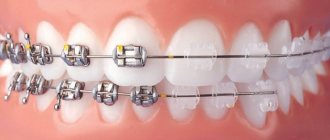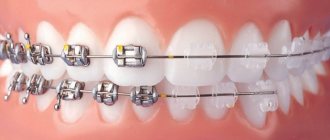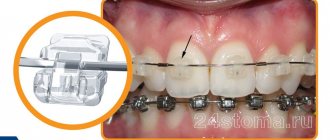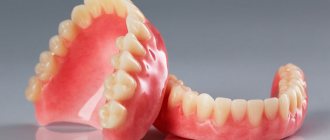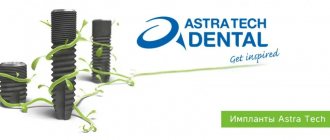Self-adjusting braces were created by specialists in the field of aesthetic dentistry. The reason for this was the reluctance of many patients to walk with a sufficiently voluminous structure. I was embarrassed by the aesthetic appearance, discomfort due to overload and difficulties during dental care.
The self-adjusting bracket system does not require ligatures. In other words, there are no rubber bands in the design; instead, reliable latches appear. With their help, heavy load on the device is eliminated and treatment time is significantly reduced. And another advantage of such brace systems is that visits to the orthodontist are limited to once every couple of months.
What are self-ligating braces?
For many years, classic ligature braces have been used to correct dental anomalies. They consisted of clasps glued to the teeth and a metal arch attached to them. The arch in such a system is attached to the clasps with ligatures - elastic rings or wire rings, and to the side teeth - with metal rings. The arch is fixed so that its traction helps straighten the teeth in the right direction. Ligature braces are still widely used today, but they require frequent visits to the doctor to correct the tension of the arch and change the ligatures (they quickly stretch and change color).
In the mid-90s of the last century, a new type of braces systems appeared - non-ligating or self-ligating. The difference between self-ligating braces and ligature braces is that instead of ligatures, they use special caps with clasps, through which an arch is threaded, like through channels. Getting rid of ligatures brought significant relief both to the orthodontist when installing braces and to the patient while wearing them. Currently, both ligature and non-ligature braces are used.
Differences between ligature and self-ligating braces
Main brands of self-ligating non-ligating braces
Popular brands of non-ligation systems include Damon, Clarity, Experience, In Ovation, H4.
Damon.
Perhaps the most famous brand of braces without ligatures. Its product line includes designs to solve any problems with bite and misalignment of teeth. The main advantage of these American systems is the damper mount developed by the company. It simplifies the archwire replacement process and reduces correction time.
Experience.
Japanese non-ligature designs, characterized by the small size of the clasps and their structure. Each clasp fits very tightly to the tooth enamel. Plus Experience controls the movement of each tooth.
Clarity SL.
Damon's main competitors. They are made of ceramic, but the groove in their clasps is made of stainless steel. This guarantees smooth sliding of the arc, as in metal systems. At the same time, they are classified as aesthetic systems, since they are invisible on the teeth. Treatment duration with Clarity SL is typically reduced by 25%. However, it all depends on the clinical picture.
In Ovation C.
These are ceramic non-ligature structures from the American company DENTSPLY. These systems are designed to prevent incorrect fixation. In Ovation C clasps are 100% protected from discoloration during wear - for this, the manufacturer coated them with a layer of zirconium dioxide.
H4.
Another self-ligating braces made in America. They are distinguished by a low profile of the locks and a minimum size of the groove for the orthodontic arch. Allows better control of treatment at the final stage.
Advantages and disadvantages of non-ligature systems
Self-ligating non-ligature braces have a number of advantages over classic ligature braces. They:
- thinner, more elegant, less noticeable;
- provide easier adaptation of the patient to them;
- are installed quickly, since there is no need to attach the arc separately to each lock, it is simply threaded through the caps;
- allow precise adjustment of the system taking into account the required trajectory;
- do not require frequent correction: you need to visit the orthodontist no more than once every two months, whereas after installing ligature braces - once a month or even more often;
- physiological, do not have a negative effect on periodontal tissues;
- reduce the duration of correction;
- do not require much maintenance effort compared to ligature ones (food debris gets stuck mainly in the ligatures).
The disadvantage of non-ligature self-ligating braces is their higher price compared to ligature ones.
Which braces to choose - with or without ligatures?
Non-ligature braces look more aesthetically pleasing than classic ligature braces, reduce the number of visits to the orthodontist, correct the bite faster, move teeth more gently, and can be used for periodontal diseases. Thanks to the design of self-ligating systems, the process of their correction takes fifteen to twenty minutes. In addition, the absence of ligatures protects against pain that can occur if the orthodontist “tightens” the ligature.
The disadvantage of self-ligating structures is their high price. Apparently, for this reason, classic ligature systems are still very popular. They are especially often chosen by teenagers and young people, who, in addition to saving money, receive another bonus - the opportunity to experiment with the color of the ligatures, making their braces unique, emphasizing their individuality.
In general, when choosing an orthodontic system, doctors and patients are guided by two principles - the ability to effectively get rid of malocclusion pathology and the ability to pay for treatment. Both ligature and non-ligature constructions allow you to achieve the desired result.
Types of self-ligating braces
Liature-free braces are divided into types according to their mechanism of action, material of manufacture and brands of individual manufacturers (brands).
By mechanism of action
Based on this feature, ligature-free braces are divided into two types:
- active – the cap (clip) exerts active pressure on the arc, forcing it to move in the desired direction;
- passive - the lid does not affect the arc in any way, it simply holds it in the lock; it is believed that this is a more natural type of correction that does not injure the periodontal tissues.
By material
Metal and ceramic self-ligating systems
Self-ligating braces are made from metal, dental ceramics and artificial sapphires. The strength and volume of the model, as well as indications for its use and aesthetics, depend on the material of manufacture.
Metal self-ligating braces
The most popular and reliable non-ligature models. Advantages:
- durable, reliable bracket systems, do not break, suitable for correcting any anomalies;
- easy to install and remove;
- cheaper than models made from other materials.
The disadvantages of metal structures include their low aesthetics: metal braces, even with the smallest locks, will always be visible when you smile.
Ceramic self-ligating braces
Also popular models are made of durable white dental ceramics in different shades. They are installed by patients who want to look more aesthetically pleasing. Advantages of metal self-ligating bracket systems:
- lighter and more comfortable to wear;
- you can choose the color of the locks exactly to match the color of your own teeth and they will be invisible, since they do not give glare;
- the adaptation period passes quickly, there is practically no discomfort or speech impairment;
- do not injure the soft tissues of the oral cavity.
Disadvantages of ceramic structures:
- more fragile compared to metal ones, sometimes they break and are not used for the correction of complex malocclusions;
- more expensive than metal ones;
- the metal arc is still visible when you smile.
Sapphire self-ligating braces
Made from transparent artificial sapphires, characterized by high strength and brilliance. Advantages:
- aesthetics - the reflection of light makes the metal arch less noticeable and gives the smile a radiance;
- stronger than ceramic ones, but inferior in strength to metal ones; therefore, they are used to correct some complex malocclusions, but still not all;
- do not have a negative effect on surrounding tissues.
Disadvantages of sapphire models:
- require more careful care, as they can quickly lose transparency due to plaque;
- the most expensive.
By brand
Global manufacturers are constantly improving their models and brand lines. Externally similar designs can differ significantly in their properties and correction efficiency. Below you can find the most popular brands of self-ligating braces.
Self-ligating Damon braces (Ormco, USA)
The Damon line of self-ligating braces is the most popular in our country. The designs are easy to use and reliable due to improved valves with locks, allowing you to quickly install and remove the system. Popular Damon (Daimon) models:
- Damon Q self-ligating braces - a comfortable and ultra-reliable design made from a hypoallergenic metal alloy, is very popular among orthodontists and their patients. A passive type of traction is used, which allows you to cope with any anomalies of the dentition in a shorter time compared to other systems. Small clasps help patients quickly adapt and do not cause them discomfort when wearing braces. The model costs a lot, but is cheaper than designs made from other materials;
- Damon Clear are aesthetic ceramic braces made of highly wear-resistant material based on aluminum. The improved locking shutter allows for quick installation and removal of the system. The model is reliable, but less durable than metal structures, so it is not used to correct complex malocclusions, and it is also very expensive.
Damon Q braces
Damon Clear braces
Clarity SL (3M Unitek, USA)
The company is a leader in the production of bracket systems: the Clarity SL model of self-ligating ceramic braces successfully competes with Damon Clear. Increased reliability of the design is provided by the use of metal to strengthen the channels (the arc passes through them) in the locks. The model is aesthetic and almost invisible on the teeth, but is not intended for the correction of complex anomalies. But its price is lower than that of Damon Clear.
Clarity SL braces
Experiense (GC Orthodontics, Germany)
German products are traditionally of high quality. Experience metal – self-ligating braces of high reliability due to clasps made of ultra-strong, non-oxidizing metal. They are cheaper than the Damon Q system, but are in no way inferior to it in quality, and are used to correct malocclusions of any complexity.
In Ovation (Dentsply, USA)
The In Ovation (Innovation) line from the American company Dentsply is also distinguished by its aesthetics and reliability. It includes models:
- In Ovation R are metal self-ligating braces with a special locking design that allows you to set the desired arch tension and distance between the locks. The design is very reliable and can be used to treat complex malocclusions;
- In Ovation C is a ceramic aesthetic model. The clasps are coated with zirconium dioxide to prevent discoloration. The design features of the model prevent its incorrect installation. These are high quality braces and are cheaper than Damon Clear.
In Ovation R braces
Self-ligating brackets H4 (Ortho Classic, USA)
H4 are high quality metal self-ligating braces made from fully biocompatible metal. Their special feature is the miniature clasps, located as close as possible to the gums, so that the h4 system is practically invisible when smiling. The system is comfortable to wear and does not irritate soft tissues.
H4 braces
Brand lines of Forestadent, Germany
The oldest German company presents a line of four self-ligating models:
- QuicKlear is a self-regulating ceramic design. A special feature is a metal flap with clasps for threading the arc. The flap is polished, has a matte color and almost does not differ from the locks in color, the locks are flat, their edges are rounded. They actively influence the arc, ensuring its movement in the desired direction. This is a reliable and beautiful model;
- TruKlear is an improved version, a ceramic self-ligating model with a ceramic lid. Special ceramics do not change its color, which is why the design is almost invisible on the teeth;
- BioQuick – active self-ligating ceramic braces with small clasps. A special feature of the design is the quick fixation of the locks with special protrusions on their base. The force holding the arc in the groove allows it to be moved in the desired direction;
- BioPassive – passive self-ligating ceramic braces. Passive action is achieved through a flexible cap and deep grooves that reduce arc friction. Effective correction is combined with a soft, non-traumatic effect on periodontal tissues.
What materials are ligature-free braces made from?
Locks for self-ligating structures are made from the same materials as for classic ligature braces - metal, ceramics and artificial sapphires.
Metal self-ligating braces
They are the easiest to install and remove. These durable, reliable systems correct all malocclusion pathologies and effectively move teeth into the desired position. Cheaper than designs made from other materials, therefore popular with patients.
Self-ligating ceramic braces
They are made from durable white dental ceramics in different shades, so they look more attractive than metal ones. The clasps of such systems are invisible, since the ceramics merge with the tooth enamel. The only noticeable detail is the orthodontic arch. They have one drawback - fragility compared to structures made from other materials.
Sapphire self-ligating braces
Like ceramic ones, they are almost invisible on the teeth. They are, of course, not made from natural sapphires - otherwise their price would be very high. During production, a transparent artificial material is used, the characteristics of which are identical to sapphires. They reflect light and make your smile really sparkle. Sapphire braces are more often used in the treatment of complex malocclusion pathologies; they are stronger than ceramic ones.
Indications for installation
Self-ligating braces are installed to correct the following anomalies:
- malocclusion - improper closure of teeth; metal models are used to correct complex malocclusions, which eliminates the need for surgery;
- curvature, uneven position, crowding of teeth or large gaps (three spaces) between them;
- unerupted (impacted) teeth – braces help to pull them out:
- disorders of the temporomandibular joint, causing difficult painful movement of the jaws, increased muscle tone;
- displacement of the dentition caused by prolonged absence of teeth, leading to facial asymmetry;
- to improve the appearance of the face in profile;
- in preparation for prosthetics or implantation to expand the gap between teeth, if the tooth has been missing for a long time and the gap has decreased.
The orthodontist decides together with the patient whether to choose self-ligating or ligature braces. The approach to selection should be individual, taking into account the characteristics of the existing pathology, aesthetic preferences and the cost of the design. Ligature-free braces are more expensive and do not require frequent visits to the doctor, so they are more often installed on adult patients. Children (not earlier than 8–9 years old and only on permanent teeth) and adolescents can have both types of braces installed, but they are still more often fitted with metal ligature models. Read more about braces for children here.
Ceramic and sapphire models are not suitable for children, as they are quite fragile and can injure a child if broken.
Self-adjusting braces price
The cost depends on the level of the clinic, the material used and the complexity of the clinical case. As already mentioned, non-ligation brace systems are much more expensive than traditional analogues, so the price for metal models will vary from 30,000 rubles, and for ceramic ones from 35,000 rubles and can even reach 100,000 rubles. Please note that these are amounts for one jaw. If a brace system is needed on both jaws, the only way to save money would be to install ceramic braces on the upper jaw, as they are more noticeable, and metal ones will be installed on the lower jaw, since this will not affect the quality of the work.
Contraindications
The installation of self-ligating structures also has contraindications. They can be absolute (correction is never carried out) and relative (correction can be carried out under certain conditions or after some time).
Absolute contraindications include:
- some common diseases that lead to decreased immunity and increased risk of infection of periodontal tissues - diabetes mellitus, immunodeficiency, blood diseases, cancer;
- severe chronic infections - AIDS, open tuberculosis;
- mental illnesses that prevent the patient from contacting the orthodontist, epilepsy;
- changes in the bone tissue of the jaw (atrophy, osteoporosis) - a thinned bone may not withstand the load;
- the absence of several teeth in the dentition at once - treatment should be carried out by an orthodontist together with an orthopedist.
Relative contraindications:
- infectious and inflammatory diseases of the oral cavity, teeth and periodontal tissues - stomatitis, caries, periodontitis;
- degenerative-dystrophic periodontal diseases - periodontal disease;
- the presence of implants and fixed dentures in the dentition - the issue of installing braces should be decided by the orthodontist together with the orthopedist;
- bruxism – grinding of teeth, mainly during sleep;
- allergies to dental materials – selection of materials will take some time;
- pregnancy and lactation;
- any acute diseases and exacerbation of chronic diseases.
Price
The cost of orthodontic treatment depends on the manufacturer and material. Our clinic has promotional offers that provide payment in installments for treatment.
What is included in the cost of the annual course and payment terms:
- diagnostics - free;
- braces + installation - first payment (the amount depends on the type of system);
- corrections, consultations - monthly, fixed payment for all types of braces;
- withdrawal is free.
Installation of self-ligating braces
When making an appointment with an orthodontist in the clinic, the patient must be asked for consent to the processing of personal data. The installation of any braces system consists of several stages: diagnosis, treatment of the identified pathology and the actual installation of braces.
Diagnostics
To install a bracket system, you must first make sure that there are no contraindications for this procedure. During the consultation, the orthodontist carefully examines the patient and then sends him for an additional examination: a survey radiography of the upper and lower jaw to identify bone tissue pathology. If necessary, a computed tomography (CT) scan of the jaw and magnetic resonance imaging (MRI) of the temporomandibular joint are performed, and a referral is made to a dentist-therapist. The therapist examines the oral cavity, identifies caries and inflammatory gum diseases.
Treatment
All identified pathologies are treated: carious teeth, stomatitis. If necessary, damaged teeth are removed. Periodontitis and periodontal disease are treated to a state of stable remission. This is followed by professional teeth cleaning and polishing.
Installation of non-ligature systems
The orthodontist installs a mouth opener, cleans and dries the teeth. After this, step by step:
- glues a lock to each tooth using special dental cement; for final fixation, the adhesive-cement is treated with ultraviolet rays, and its remains are removed; Most often, the structure is installed first on one jaw - the upper one, and after 2 weeks - on the lower one - this makes adaptation easier;
- when the cement has completely hardened, an arc is pulled through the grooves of the locks and each lock is closed with a lid; they snap tightly and securely hold the metal arc; the structure is secured on the sides with rings on the chewing teeth, most often 6 or 7.
During installation, the patient does not experience pain. The entire procedure for installing self-ligating braces lasts about an hour. You will need to visit the orthodontist once every 2 months to monitor and adjust (activate) the system.
How are ligature-free systems installed?
The process of fixing self-ligating non-ligature structures is no different from installing classical ligature systems.
- Before fixing the structure, a full examination of the oral cavity is carried out; sometimes, to achieve the desired result of orthodontic treatment, teeth are removed and dentures are installed. All carious lesions must be removed and professional cleaning carried out.
- Locks of the chosen design are fixed to the teeth. This happens with the help of dental glue. This is the most critical stage: incorrectly installed locks will negatively affect the duration and quality of treatment.
- If necessary, the remaining glue is removed, and the clasps are finally secured to the teeth using a lamp with ultraviolet light.
- On the side, on the chewing teeth, orthodontic rings and locks are fixed.
- All installed locks are connected to each other by means of an orthodontic arch, which is fixed in their grooves.
Installation of the system takes about one hour. But the preparatory stage may well last for several weeks or even months - it all depends on the initial condition of the patient’s oral cavity.
Caring for self-ligating braces
Non-ligature braces are easier to care for than ligature braces, as food is less likely to get stuck in them. But careful care is necessary, otherwise bacterial plaque will form on the teeth and caries will begin. To prevent this from happening, you need to maintain oral hygiene:
- brush your teeth twice a day with a special V-shaped toothbrush;
- After each meal, even after drinking juice or milk, rinse your mouth thoroughly; If there are food particles left in the teeth, they can be removed with a stream of water from an irrigator or using an interdental brush.
You should also follow the nutritional recommendations:
- in the first week after installing the system, you need to eat soft food, then gradually switch to harder food; but foods such as nuts and seeds will need to be excluded;
- limit the consumption of sweets and sugary drinks - this is an excellent breeding ground for bacteria;
- You should not eat foods that stick to your teeth – chewing candies, chewing gum.
Description of ligature braces
The figure shows how the power arch is attached to the bracket pad: the ligature firmly fixes the arch, preventing it from moving.
In ligature systems, 2 fastening options are used:
- rubber rings. They can be colorless, white or colored. They deform (stretch) quite quickly, so they must be replaced every 3 to 4 weeks. As a rule, they are used in the initial stages of therapy, because with their help the arc exerts a mild force effect;
- wires made of steel, aluminum or silver alloy. The arch is secured with such ligatures at the final stages of treatment.
Ligature orthodontic devices cope with pathology of any severity, if it is, in principle, subject to conservative treatment. These braces can be metal or ceramic. Metal ones have a lower cost, but are inferior to ceramic ones in terms of aesthetics. Therefore, our dentists recommend ceramic braces to those patients who would like to look as attractive as possible during treatment.
Possible complications
With proper installation, there are practically no complications, but in the first 1 - 2 weeks unpleasant symptoms may appear:
- discomfort in the oral cavity; with non-ligature models, which are small in size, this goes away quickly;
- speech impairment - disappears within 2 - 4 weeks; to speed up the process, you need to talk and read aloud more;
- dry lips – this symptom may bother you during the entire period of wearing braces; it can be reduced with the help of special moisturizing cosmetics;
- pain in the teeth - if the surrounding soft tissues are not inflamed, then this is due to the movement of the teeth in the desired direction; after some time, the tissues adapt to the impact, and the pain goes away;
- pain associated with irritation of the gums, tongue and inner surface of the cheeks; to prevent inflammation from developing, it is recommended to rinse your mouth with antiseptic solutions - infusion of chamomile flowers, calendula, Miramistin; over time all this passes;
- headaches - they are not so common, but sometimes wearing braces provokes their appearance; in such cases, you need to visit an orthodontist, make sure that the system is installed correctly, and then contact a neurologist.
Urgent medical attention is required if the following symptoms appear:
- redness, swelling of the gums, the appearance of ulcers in the mouth with an increase in body temperature, loosening of teeth, increasing pain - these signs appear as a result of improper installation of the system;
- the appearance of carious spots on tooth enamel.
The best models of non-ligature metal braces
- Damon Q. Implantmaster orthodontists correct the bite using self-ligating metal braces Damon Q. These braces perfectly correct difficult clinical cases in the shortest possible time. The system itself is perfectly individualized for each patient.
- Damon 3MX. For a long period of time, these plates were considered the most effective among non-ligature ones. The main advantages are smooth edges and a small width of the plate, which ensures comfortable wearing and quick adaptation;
- Smart Clip. The system has an exclusive patented plate snap mechanism. This ensures precise control of the arc force, and the ability to change it to increase the efficiency of bite correction;
- In-ovation R. A small bracket system that allows you to fix arches of different sizes in the grooves. Also, the unique structure of the structure has an additional effect on the arch, reducing the period of corrective treatment.
How much does it cost to install ligature-free braces?
The cost of installing self-ligating braces consists of:
- cost of examination and preliminary treatment;
- the orthodontist’s work on installing the structure;
- prices of braces depending on the brand;
- geographic location and reputation of the clinic.
Approximate prices for different brands of non-ligature braces for one jaw:
- Damon Q: 27–50 thousand rubles.
- Damon Clear: from 60 thousand rubles.
- In-Ovation R: 40 thousand rubles.
- In-Ovation C: from 45 thousand rubles.
- Activation of a self-ligating brace system from RUB 2,800.
The main advantages of self-regulating bracket systems
A distinctive advantage of braces is the use of small physiological forces. According to reputable doctors and other specialized specialists, this approach makes it possible to significantly reduce the trauma of the entire process of occlusion correction and can reduce treatment time by 25%.
Some self-ligating braces allow for more individualized correction, as it is possible to program the bracket system for how each tooth should be positioned. This makes the process of moving teeth much more predictable, and the result optimal.
A huge variety of such brace systems makes it possible to choose exactly the one that is best suited in each individual case. For people who value maximum functionality rather than aesthetics, orthodontists recommend durable self-ligating metal braces. And ceramic bracket systems are perfect for people who are accustomed to giving preference to aesthetics. However, there are also compromises: the same non-ligature braces, which ideally combine the strength of steel and the aesthetics of ceramics.
Advantages of using ligature-free braces
- Self-adjusting braces do not have hooks and take up very little space in the mouth. This significantly reduces adaptation time and makes oral care easier.
- Also, ligature-free braces are the only method of teeth straightening that can be offered by a doctor to a patient with periodontal disease.
- During the installation of self-ligating braces, the patient can avoid wasting his time and come for an appointment once every 3 months.
- The arc change time, thanks to the clamps, takes 10-15 minutes.
- Well, the main difference between self-ligating braces and ligature braces is that teeth are straightened with the help of the muscles of the tongue, cheeks and lips, and a positive result is achieved faster and lasts for a long time.
- Ligature-free braces apply little pressure on the oral mucosa, resulting in a reduction in trauma to almost zero.
- To successfully continue treatment, it is enough to rarely visit the doctor once every 2-3 months.
- They are made from proven and pure materials that do not interact with the environment in the oral cavity.
- The absence of ligatures in such brace systems greatly simplifies oral care for patients.
- Patients wearing such braces quickly get used to them due to their optimal size.
- When correcting your bite, you will not have to remove teeth.
- The alignment process is calculated for all teeth separately.
- Their design guarantees continuous operation of the archwire, which is why you do not have to go to a specialist to activate your braces. This is very important for patients who do not have enough time to visit the dentist.
- Self-ligating braces have a pleasant appearance.
- Removal and installation of the structure takes place as quickly as possible.
Peculiarities
This design completely eliminates ligatures. They have been replaced by convenient locks with an automatic latch, which ensure free movement of the arc in the grooves.
Thanks to innovative technology, the patient no longer needs frequent visits to the dental clinic to correct the pressure exerted by the arc. The pressure on the dentition now changes without medical intervention. There is no need to change the ligatures, so visits to the doctor can be reduced to once every three months.
Key Benefits
Since little physical force is used during the treatment, adaptation is less painful and the patient feels as comfortable as possible. Also, ligature-free braces models guarantee less trauma and faster achievement of your goals.
Certain types of systems make it possible to correct the bite according to a pre-programmed scenario, that is, the treatment becomes more individual. This technology allows you to set the desired position of each tooth and predict the outcome of treatment as much as possible.
For those patients for whom the aesthetic side of the issue is not so important and who want to save on treatment, professionals recommend metal structures. They are the most effective and guarantee optimal results within 1.5 to 2 years.
Those people who are worried about their attractiveness and communicate a lot with others can be advised to wear braces made of ceramic or artificial sapphire.
Key advantages of self-regulating braces systems:
- They are smaller in size due to the lack of special hooks. This makes the habituation process faster and maintenance simpler.
- Suitable for patients with periodontal diseases.
- Rare visits to the clinic for examination and correction. Saving.
- The arc can be replaced in the shortest possible time period; it does not take more than 15 minutes.
- The effect is noticeable faster due to the fact that the muscles of the cheeks, lips and tongue are additionally involved in straightening the teeth.
- The result obtained lasts for a long time.
- Less trauma while wearing the system due to the lack of friction of the elements against soft tissue.
- Braces are made from hypoallergenic materials.
- Brushing your teeth becomes much easier.
- Dismantling the structure is quick and painless.
Minuses
Unfortunately, non-ligature braces have one single drawback - the rather high cost of manufacturing and installation. This is easy to explain, since the design itself is more complex, and not every doctor has sufficient qualifications to install it. That is why you should not believe numerous advertisements that promise excellent results for less money. Never save on your health, because it is better to overpay a little, but at the same time be sure of an impeccable result. Only a true professional will conduct a detailed consultation, tell you about all the nuances of the upcoming treatment, risks and guarantees. Having a complete understanding of the installation process and further restoration, you will be more loyal to the high cost of the technician’s work.

